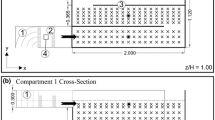Abstract
Scalar mixing is under the joint control of convection and diffusion. The ratio of the dissipative scale of velocity field to that of the scalar field depends on the Schmidt number. In the high Schmidt number limit, the scalar scale is much smaller than that of the momentum, which then requires either special treatment or ad hoc models for the scalar quantity in numerical simulations. In order to avoid model uncertainty or unnecessary numerical complexity, the direct numerical simulation is performed for studying the scalar mixing process in a confined rotating mixer tank. It has been found that in the range of negligible numerical diffusivity, the characteristic scalar mixing time is inversely proportional to the scalar diffusivity. Analysis based on the dimensional argument justifies such scaling relation as well, from which the unaccepted computational time of the mixing process in the high Schmidt number limit can be efficiently determined, without the use of ad hoc models. This scaling idea is also of practical meaningfulness for other similar problems.
Similar content being viewed by others
References
National Research Council. Reusable launch vehicle: Technology development and test program [R]. Washington, DC: The National Academies Press, 1995.
ZHANG J Z, ZHANG S C, WANG C H, et al. Recent advances in film cooling enhancement: A review [J]. Chinese Journal of Aeronautics, 2020, 33(4): 1119–1136.
KUMAR C V, KANDASUBRAMANIAN B. Advances in ablative composites of carbon based materials: A review [J]. Industrial & Engineering Chemistry Research, 2019, 58: 22663–22701.
POLEZHAEV Y V. Modern problems of thermal protection [J]. Journal of Engineering Physics and Thermophysics, 2001, 74(6): 1364–1374.
MILLER R A. Current status of thermal barrier coatings: An overview [J]. Surface and Coating Technology, 1987, 30: 1–11.
MEIER S M, GUPTA D K, SHEFFLER K D. Ceramic thermal barrier coatings for commercial gas turbine engines [J]. The Journal of the Minerals, Metals & Materials Society (TMS), 1991, 43: 50–53.
PADTURE N P, GELL M, JORDAN E H. Thermal barrier coatings for gas-turbine engine applications [J]. Science, 2002, 296: 280–284.
XU H B, GONG S K, DENG L. Preparation of thermal barrier coatings for gas turbine blades by EB-PVD [J]. Thin Solid Films, 1998, 334(1/2): 98–102.
STRANGMAN T E. Thermal barrier coatings for turbine airfoils [J]. Thin Solid Films, 1985, 127: 93–106.
ROSÉN C, TRÄGȦRDH C, DEJMEK P. Turbulent high-Schmidt number mass transfer in UF [M]//Developments in food engineering. Boston, MA: Springer, 1994: 644–646.
SUGA K, KUBO M. Modelling high Schmidt number turbulent scalar transport across air-water interfaces [C]//Sixth International Symposium on Turbulence and Shear Flow Phenomena, Seoul: Begel House Inc., 2009: 545–550.
PHILLIPS D H, LANNUTTI J J. Measuring physical density with X-ray computed tomography [J]. NDT & E International, 1997, 30(6): 339–350.
GONZALEZ R C, WOODS R E. Digital image processing [M]. 3rd ed. Upper Saddle River, NJ: Prentice-Hall, Inc., 2007.
HWANG J Y, YANG K S, BREMHORST K. Direct numerical simulation of turbulent flow and mass transfer around a rotating circular cylinder [C]//ASME Fluids Engineering Division Summer Meeting and Exhibition. Houston, TX: ASME, 2005: 347–352.
JUNG R T, SATO T. Numerical simulation of high Schmidt number flow over a droplet by using moving unstructured mesh [J]. Journal of Computational Physics, 2005, 203(1): 221–249.
SCHWERTFIRM F. Direct simulation and modelling of micro-mixing in high Schmidt number flows [J]. ERCOFTAC Bulletin, 2009, 81:6–7.
ZIKANOV O. Essential computational fluid dynamics [M]. Hoboken, NJ: John Wiley & Sons, Inc., 2010.
Acknowledgement
We acknowledge the computing resource support from the National Supercomputer Center in Guangzhou, China.
Author information
Authors and Affiliations
Corresponding author
Rights and permissions
About this article
Cite this article
Sun, N., Wang, L., Li, Y. et al. Scaling Relation of the Scalar Diffusion in a Rotating Mixer. J. Shanghai Jiaotong Univ. (Sci.) 26, 170–175 (2021). https://doi.org/10.1007/s12204-021-2275-7
Received:
Accepted:
Published:
Issue Date:
DOI: https://doi.org/10.1007/s12204-021-2275-7




